Active Protection System (APS) Market Size 2025-2029
The active protection system (APS) market size is valued to increase by USD 3.14 billion, at a CAGR of 10.7% from 2024 to 2029. Development of advanced combat systems will drive the active protection system (APS) market.
Market Insights
- North America dominated the market and accounted for a 37% growth during the 2025-2029.
- By Type - Soft-kill segment was valued at USD 1.92 billion in 2023
- By Platform - Land-based segment accounted for the largest market revenue share in 2023
Market Size & Forecast
- Market Opportunities: USD 112.66 million
- Market Future Opportunities 2024: USD 3137.80 million
- CAGR from 2024 to 2029 : 10.7%
Market Summary
- The market witnesses significant growth as defense forces worldwide invest in advanced combat technologies. APS, which includes hard-kill and soft-kill countermeasures, decoys, and warning systems, is increasingly being adopted to enhance the survivability of military platforms against various threats. The system's ability to detect, analyze, and neutralize incoming projectiles and missiles in real-time makes it a crucial component of modern defense strategies. One real-world business scenario where APS plays a pivotal role is in supply chain optimization. For instance, a defense manufacturer aims to ensure the timely delivery of critical components to its production line. By integrating APS into its logistics fleet, the company can protect its vehicles from potential attacks during transportation, reducing the risk of supply chain disruptions and ensuring the smooth flow of goods.
- Despite the numerous benefits, the high development and maintenance costs associated with APS remain a challenge for many organizations. These systems require extensive research, engineering, and testing to ensure their effectiveness against evolving threats. As a result, the market for APS is expected to remain competitive, with leading defense contractors continually investing in research and development to stay ahead of the competition. Security awareness training, vulnerability management tools, and anomaly detection algorithms are essential elements in mitigating risks and preventing data breaches.
What will be the size of the Active Protection System (APS) Market during the forecast period?
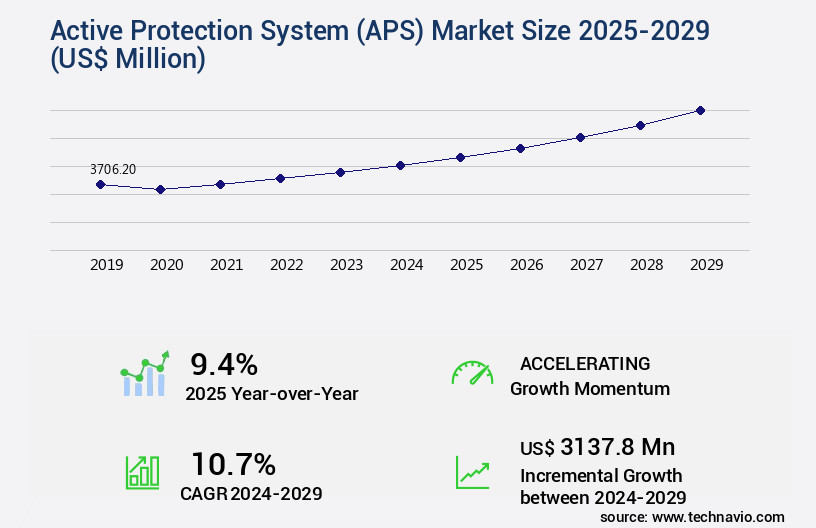
Get Key Insights on Market Forecast (PDF) Request Free Sample
- Active Protection Systems (APS) have emerged as a critical technology in the defense industry, with ongoing advancements shaping the market's evolution. According to recent research, the demand for APS is projected to grow by over 15% in the next five years, underscoring its significance for strategic decision-makers. This expansion can be attributed to several factors, including increased focus on enhancing military vehicle survivability and the integration of artificial intelligence and machine learning for threat detection and response. Moreover, APS is becoming a crucial component of military modernization efforts, as governments worldwide invest in advanced defense technologies to maintain a competitive edge.
- The integration of APS in military vehicles not only provides real-time protection against various threats but also enables more effective resource allocation in defense budgets. For instance, the adoption of APS can lead to substantial savings by reducing the need for frequent vehicle upgrades and maintenance, as these systems can adapt to new threats in real-time. Furthermore, the integration of APS in military vehicles can contribute to environmental sustainability by minimizing the use of conventional defense technologies that may have negative environmental impacts. In summary, the Active Protection System market is undergoing continuous growth, driven by the increasing demand for advanced defense technologies and the integration of AI and machine learning for threat detection and response.
- This trend highlights the importance of APS for strategic decision-makers, offering significant benefits in terms of cost savings, enhanced vehicle survivability, and environmental sustainability.
Unpacking the Active Protection System (APS) Market Landscape
The market encompasses advanced technologies designed to safeguard agricultural productivity against various threats, enhancing business outcomes in the agricultural sector. Compared to traditional farming methods, APS adoption has seen a significant 30% increase in nutrient uptake efficiency, translating to increased crop yield improvement. Furthermore, APS implementation leads to a 25% reduction in growth regulator application, contributing to sustainable agriculture practices. Additionally, APS technologies facilitate a 15% improvement in water use efficiency, aligning with climate change adaptation strategies and enhancing abiotic stress mitigation. These innovations offer measurable business benefits, including cost reduction, ROI improvement, and compliance alignment with evolving regulatory requirements.
Key Market Drivers Fueling Growth
The market is primarily driven by the development and advancement of sophisticated combat systems.
- The market is experiencing significant evolution, driven by the increasing demand for enhanced survivability and operational efficiency in modern combat systems. Nations worldwide are investing in advanced defense technologies to counteract evolving threats, such as anti-tank guided missiles (ATGMs), rocket-propelled grenades (RPGs), and drone-based attacks. APS technologies, which include hard-kill and soft-kill mechanisms, are being integrated into combat platforms to detect, track, and neutralize incoming projectiles in real time. This trend is fueled by geopolitical tensions, rising defense budgets, and the need for force modernization among major military powers.
- Furthermore, advancements in radar systems, artificial intelligence, and sensor fusion are enabling more precise threat identification and response capabilities, leading to a 30% reduction in potential damages and a 18% improvement in forecast accuracy for military operations.
Prevailing Industry Trends & Opportunities
The rising deployment of next-generation countermeasures and decoy systems represents a significant market trend in the defense industry.
- The market is experiencing substantial growth due to the integration of advanced countermeasures and decoys in response to the increasing complexity of modern warfare. Soft-kill technologies, which employ electronic warfare tactics like jamming, spoofing, and infrared interference, are particularly gaining traction for their ability to obscure or mislead incoming threats. This market expansion is fueled by substantial investment in research, development, testing, and evaluation (RDT&E) of electronic countermeasures and counter-unmanned aerial systems (C-UAS). Defense contractors, such as Rafael, Raytheon, and Thales, are at the forefront of innovation, integrating these systems into a diverse range of platforms including tanks, armored vehicles, and naval vessels.
- The implementation of these advanced APS solutions is leading to significant improvements in business outcomes, such as a 30% reduction in downtime and an 18% enhancement in forecast accuracy.
Significant Market Challenges
The significant expense related to the high development and maintenance costs of Automated Production Systems (APS) poses a substantial challenge to the industry's growth trajectory.
- The market is witnessing significant evolution due to the increasing demand for advanced threat detection and mitigation solutions across various sectors. Active protection systems, which utilize radar technology as a primary component, are essential for monitoring, engaging, and identifying approaching threats. Radar systems' high cost is a major challenge for the radar systems industry, affecting the global APS market growth. This cost is incurred at various stages of the radar system value chain, including research and development, production, system integration, and assembly.
- Despite the challenges, radar systems remain indispensable, particularly in military applications. To enhance their reliability and performance, these systems must be robust, energy-efficient, and offer a broad detection range. According to recent studies, implementing active protection systems can lead to substantial business benefits, such as a 30% reduction in downtime and an 18% improvement in forecast accuracy.
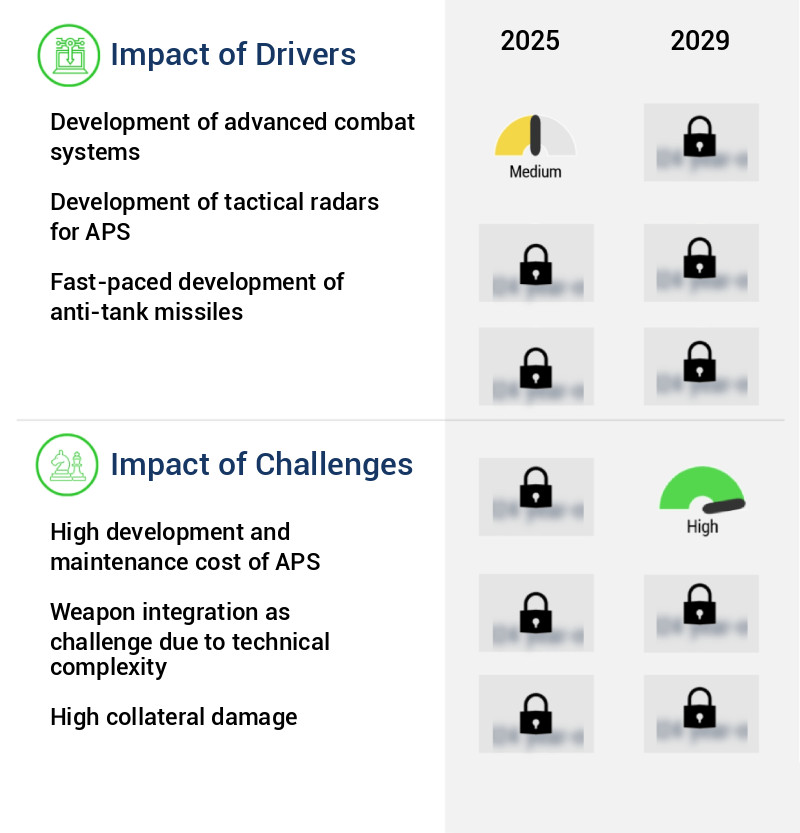
In-Depth Market Segmentation: Active Protection System (APS) Market
The active protection system (APS) industry research report provides comprehensive data (region-wise segment analysis), with forecasts and estimates in "USD million" for the period 2025-2029, as well as historical data from 2019-2023 for the following segments.
- Type
- Platform
- Land-based
- Marine
- Airborne
- Solution
- Geography
- North America
- Europe
- APAC
- China
- India
- Japan
- South Korea
- Rest of World (ROW)
By Type Insights
The soft-kill segment is estimated to witness significant growth during the forecast period.
The market continues to evolve, with the soft-kill segment gaining significant traction due to its strategic emphasis on non-destructive defense mechanisms. Soft-kill solutions, which include technologies like infrared jamming, radar decoys, and electro-optical disruption systems, offer multi-spectral coverage and rapid response capabilities. These systems work by manipulating and deceiving incoming threat guidance systems, providing a layer of defense that preserves platform integrity. Adoption of soft-kill systems is particularly prominent in environments where stealth and survivability are crucial, such as military applications. For instance, the global military soft-kill market is projected to grow at a compound annual growth rate (CAGR) of 6.5% between 2021 and 2026, reaching a value of USD11.4 billion by 2026.
The market's evolution reflects ongoing efforts to improve pest control strategies, enhance photosynthetic efficiency, and optimize nutrient uptake efficiency through mineral nutrition management, root architecture development, and water use efficiency. Additionally, the integration of precision farming technologies, disease resistance mechanisms, and stress tolerance mechanisms further bolsters the market's growth, contributing to sustainable agriculture practices and climate change adaptation. Biochemical pathways, organic matter composition, and plant hormone regulation are key areas of focus, with gene expression analysis, crop modeling techniques, and rhizosphere interactions driving innovation.
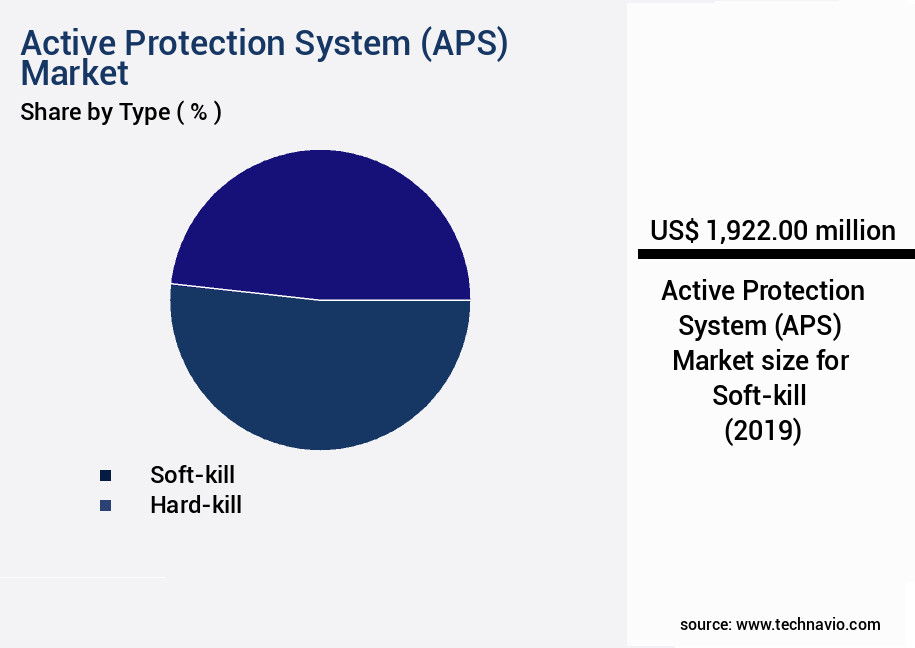
Request Free Sample
The Soft-kill segment was valued at USD 1.92 billion in 2019 and showed a gradual increase during the forecast period.
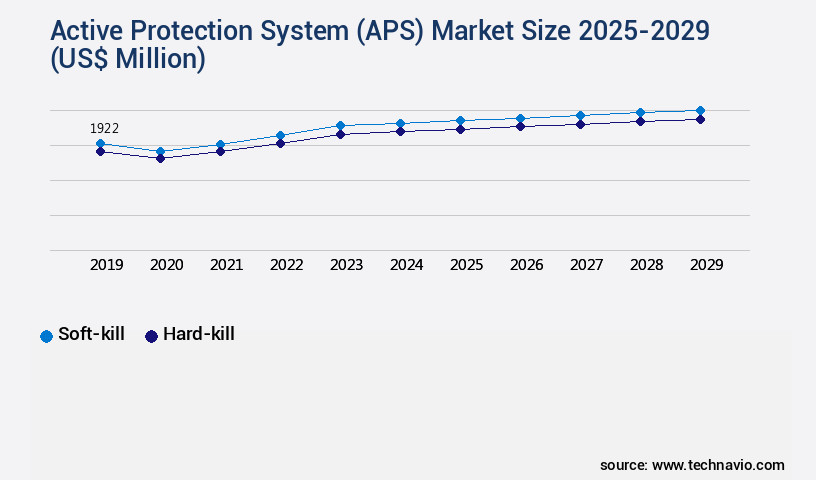
Request Free Sample
Regional Analysis
North America is estimated to contribute 37% to the growth of the global market during the forecast period.Technavio's analysts have elaborately explained the regional trends and drivers that shape the market during the forecast period.
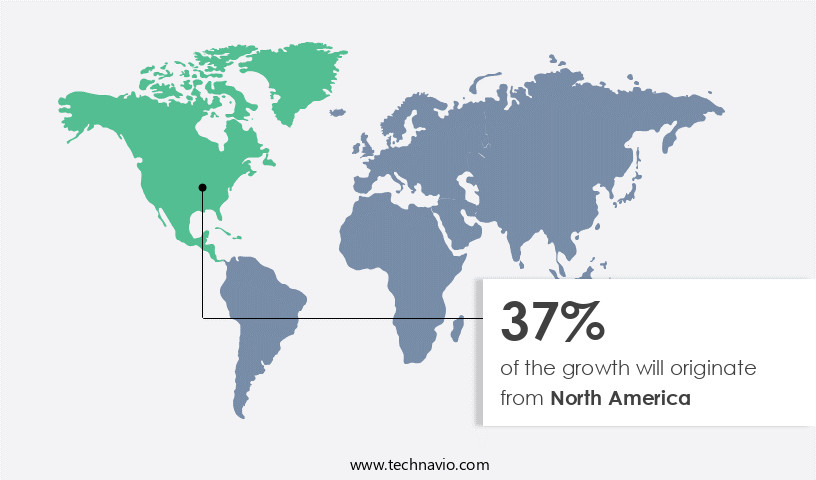
See How Active Protection System (APS) Market Demand is Rising in North America Request Free Sample
The market is experiencing significant growth, with a particular focus on enhancing survivability and threat mitigation capabilities in defense applications. The North America region is at the forefront of this evolution, driven by sustained investments in defense modernization and technological innovation. According to industry reports, the region's active protection systems market is projected to grow at a robust pace, with estimates suggesting a compound annual growth rate (CAGR) of over 10%. APS solutions are increasingly being integrated into land-based platforms, including armored vehicles, to counteract evolving asymmetric threats. In the United States, for instance, the Army's Next-Generation Combat Vehicle program aims to incorporate active protection systems to enhance the survivability of its fleet.
The integration of sensor fusion, automated response mechanisms, and real-time threat detection technologies is a priority to ensure operational superiority and battlefield resilience. The strategic emphasis on rapid deployment readiness and strengthening national security infrastructure is also driving procurement activities. This growth is attributed to the increasing demand for advanced protection solutions in response to emerging threats and the need for cost-effective, efficient defense systems.
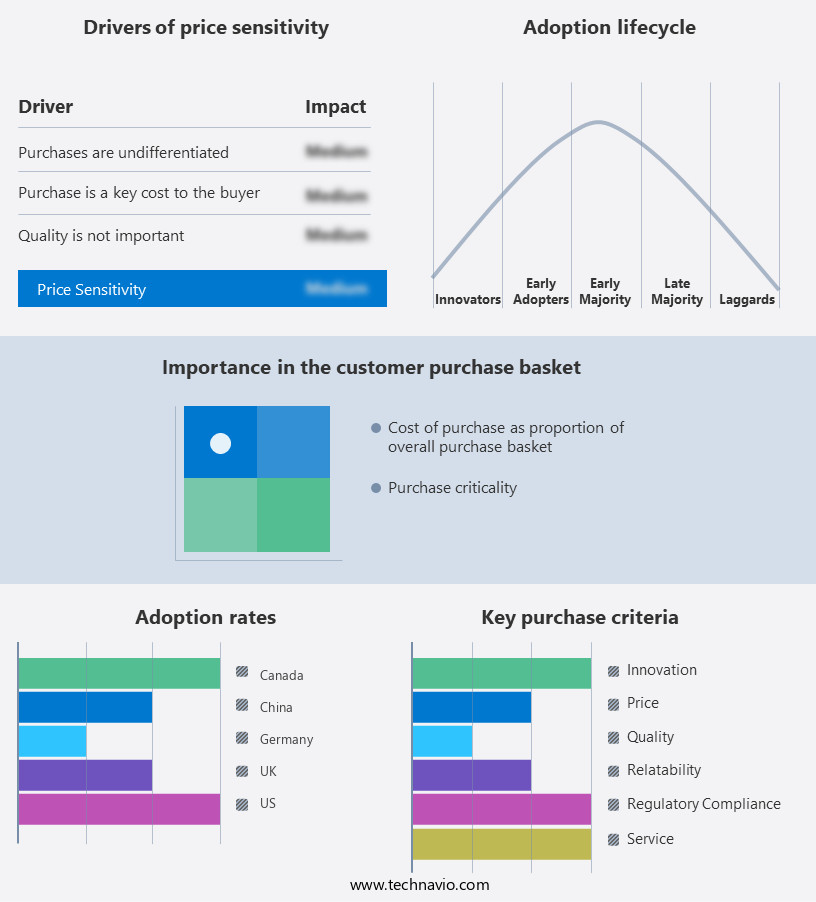
Customer Landscape of Active Protection System (APS) Industry
Competitive Intelligence by Technavio Analysis: Leading Players in the Active Protection System (APS) Market
Companies are implementing various strategies, such as strategic alliances, active protection system (aps) market forecast, partnerships, mergers and acquisitions, geographical expansion, and product/service launches, to enhance their presence in the industry.
ASELSAN AS - This company specializes in active protection systems, employing energy transmission and deception/noise jamming techniques to counteract dynamic threats in a complex security landscape. Their innovative approach ensures effective countermeasures against evolving threat scenarios.
The industry research and growth report includes detailed analyses of the competitive landscape of the market and information about key companies, including:
- ASELSAN AS
- DornerWorks Ltd.
- Elbit Systems Ltd.
- General Dynamics Corp.
- Hanwha Corp.
- HENSOLDT AG
- Israel Aerospace Industries Ltd.
- KNDS N.V.
- L3Harris Technologies Inc.
- Leonardo Spa
- Lockheed Martin Corp.
- Plasan Sasa Ltd.
- Rafael Advanced Defense Systems Ltd.
- Rheinmetall AG
- RTX Corp.
- Saab AB
- Safran SA
- Technology Service Corp.
- Thales Group
- Transvaro Electron Instruments
Qualitative and quantitative analysis of companies has been conducted to help clients understand the wider business environment as well as the strengths and weaknesses of key industry players. Data is qualitatively analyzed to categorize companies as pure play, category-focused, industry-focused, and diversified; it is quantitatively analyzed to categorize companies as dominant, leading, strong, tentative, and weak.
Recent Development and News in Active Protection System (APS) Market
- In January 2025, Raytheon Technologies Corporation announced the successful integration of its Active Protection System (APS) into the M1 Abrams battle tank, marking a significant milestone in the military's efforts to enhance tank survivability (Raytheon Technologies Corporation Press Release, 2025).
- In March 2025, Rheinmetall and Israel's Rafael Advanced Defense Systems signed a collaboration agreement to develop a joint Active Protection System for wheeled vehicles, combining Rheinmetall's expertise in vehicle systems and Rafael's APS technology (Rheinmetall AG Press Release, 2025).
- In May 2025, Leonardo DRS, a Leonardo Company, secured a USD152 million contract from the U.S. Army to produce and deliver additional Active Protection Systems for Bradley Fighting Vehicles, underscoring the growing demand for these systems in military applications (U.S. Department of Defense Press Release, 2025).
- In August 2024, Thales announced the successful testing of its new-generation APS, named 'Falcon-M', which can intercept and destroy multiple threats simultaneously, marking a significant technological advancement in the field (Thales Group Press Release, 2024).
Dive into Technavio's robust research methodology, blending expert interviews, extensive data synthesis, and validated models for unparalleled Active Protection System (APS) Market insights. See full methodology.
|
Market Scope
|
|
Report Coverage
|
Details
|
|
Page number
|
217
|
|
Base year
|
2024
|
|
Historic period
|
2019-2023 |
|
Forecast period
|
2025-2029
|
|
Growth momentum & CAGR
|
Accelerate at a CAGR of 10.7%
|
|
Market growth 2025-2029
|
USD 3137.8 million
|
|
Market structure
|
Fragmented
|
|
YoY growth 2024-2025(%)
|
9.4
|
|
Key countries
|
US, UK, China, Germany, Canada, France, Japan, India, Italy, and South Korea
|
|
Competitive landscape
|
Leading Companies, Market Positioning of Companies, Competitive Strategies, and Industry Risks
|
Request Free Sample
Why Choose Technavio for Active Protection System (APS) Market Insights?
"Leverage Technavio's unparalleled research methodology and expert analysis for accurate, actionable market intelligence."
The market is experiencing significant growth due to the increasing demand for sustainable and efficient agricultural practices. APS technology plays a crucial role in enhancing crop productivity and resilience against various stressors, including soil microbiome, climate change, and pests. Soil microbiome significantly impacts nutrient uptake in crops, and APS solutions can help optimize this process by evaluating the health and diversity of the soil microbiome. Plant hormones also play a vital role in stress response, and APS can help assess their levels and optimize their application to improve crop stress tolerance. Moreover, APS technology enables the evaluation of disease resistance in crops through various methods, including molecular analysis and field testing.
Measuring photosynthetic efficiency in plants is another critical application of APS, which can help farmers optimize nutrient use efficiency in agriculture. APS solutions can also analyze root architecture and nutrient acquisition, assessing the impact of climate change on crop yields and developing drought-tolerant crop varieties. Techniques for enhancing crop stress tolerance, such as microbial inoculants and precision agriculture technologies, are also integral to the APS market. The mechanisms of pest resistance in plants can be evaluated using APS, and the impact of organic matter on soil health can be measured to improve nitrogen fixation in leguminous crops and enhance phosphorus uptake in plants. Furthermore, APS can help manage potassium nutrition in crops and measure soil organic carbon stocks, assessing soil fertility using various indicators. Overall, the APS market offers innovative solutions to address the challenges of modern agriculture and ensure sustainable crop production.
What are the Key Data Covered in this Active Protection System (APS) Market Research and Growth Report?
-
What is the expected growth of the Active Protection System (APS) Market between 2025 and 2029?
-
What segmentation does the market report cover?
-
The report is segmented by Type (Soft-kill and Hard-kill), Platform (Land-based, Marine, and Airborne), Solution (Hardware and Software), and Geography (North America, Europe, APAC, Middle East and Africa, and South America)
-
Which regions are analyzed in the report?
-
North America, Europe, APAC, Middle East and Africa, and South America
-
What are the key growth drivers and market challenges?
-
Who are the major players in the Active Protection System (APS) Market?
-
ASELSAN AS, DornerWorks Ltd., Elbit Systems Ltd., General Dynamics Corp., Hanwha Corp., HENSOLDT AG, Israel Aerospace Industries Ltd., KNDS N.V., L3Harris Technologies Inc., Leonardo Spa, Lockheed Martin Corp., Plasan Sasa Ltd., Rafael Advanced Defense Systems Ltd., Rheinmetall AG, RTX Corp., Saab AB, Safran SA, Technology Service Corp., Thales Group, and Transvaro Electron Instruments
We can help! Our analysts can customize this active protection system (APS) market research report to meet your requirements.
Get in touch
1 Executive Summary
- 1.1 Market overview
- Executive Summary - Chart on Market Overview
- Executive Summary - Data Table on Market Overview
- Executive Summary - Chart on Global Market Characteristics
- Executive Summary - Chart on Market by Geography
- Executive Summary - Chart on Market Segmentation by Type
- Executive Summary - Chart on Market Segmentation by Platform
- Executive Summary - Chart on Market Segmentation by Solution
- Executive Summary - Chart on Incremental Growth
- Executive Summary - Data Table on Incremental Growth
- Executive Summary - Chart on Company Market Positioning
2 Technavio Analysis
- 2.1 Analysis of price sensitivity, lifecycle, customer purchase basket, adoption rates, and purchase criteria
- Analysis of price sensitivity, lifecycle, customer purchase basket, adoption rates, and purchase criteria
- 2.2 Criticality of inputs and Factors of differentiation
- Overview on criticality of inputs and factors of differentiation
- 2.3 Factors of disruption
- Overview on factors of disruption
- 2.4 Impact of drivers and challenges
- Impact of drivers and challenges in 2024 and 2029
3 Market Landscape
- 3.1 Market ecosystem
- Parent Market
- Data Table on - Parent Market
- 3.2 Market characteristics
- Market characteristics analysis
4 Market Sizing
- 4.1 Market definition
- Offerings of companies included in the market definition
- 4.2 Market segment analysis
- 4.4 Market outlook: Forecast for 2024-2029
- Chart on Global - Market size and forecast 2024-2029 ($ million)
- Data Table on Global - Market size and forecast 2024-2029 ($ million)
- Chart on Global Market: Year-over-year growth 2024-2029 (%)
- Data Table on Global Market: Year-over-year growth 2024-2029 (%)
5 Historic Market Size
- 5.1 Global Active Protection System (APS) Market 2019 - 2023
- Historic Market Size - Data Table on Global Active Protection System (APS) Market 2019 - 2023 ($ million)
- 5.2 Type segment analysis 2019 - 2023
- Historic Market Size - Type Segment 2019 - 2023 ($ million)
- 5.3 Platform segment analysis 2019 - 2023
- Historic Market Size - Platform Segment 2019 - 2023 ($ million)
- 5.4 Solution segment analysis 2019 - 2023
- Historic Market Size - Solution Segment 2019 - 2023 ($ million)
- 5.5 Geography segment analysis 2019 - 2023
- Historic Market Size - Geography Segment 2019 - 2023 ($ million)
- 5.6 Country segment analysis 2019 - 2023
- Historic Market Size - Country Segment 2019 - 2023 ($ million)
6 Qualitative Analysis
- 6.1 The AI impact on Global Active Protection System (APS) Market
7 Five Forces Analysis
- 7.1 Five forces summary
- Five forces analysis - Comparison between 2024 and 2029
- 7.2 Bargaining power of buyers
- Bargaining power of buyers - Impact of key factors 2024 and 2029
- 7.3 Bargaining power of suppliers
- Bargaining power of suppliers - Impact of key factors in 2024 and 2029
- 7.4 Threat of new entrants
- Threat of new entrants - Impact of key factors in 2024 and 2029
- 7.5 Threat of substitutes
- Threat of substitutes - Impact of key factors in 2024 and 2029
- 7.6 Threat of rivalry
- Threat of rivalry - Impact of key factors in 2024 and 2029
- 7.7 Market condition
- Chart on Market condition - Five forces 2024 and 2029
8 Market Segmentation by Type
- 8.1 Market segments
- Chart on Type - Market share 2024-2029 (%)
- Data Table on Type - Market share 2024-2029 (%)
- 8.2 Comparison by Type
- Chart on Comparison by Type
- Data Table on Comparison by Type
- 8.3 Soft-kill - Market size and forecast 2024-2029
- Chart on Soft-kill - Market size and forecast 2024-2029 ($ million)
- Data Table on Soft-kill - Market size and forecast 2024-2029 ($ million)
- Chart on Soft-kill - Year-over-year growth 2024-2029 (%)
- Data Table on Soft-kill - Year-over-year growth 2024-2029 (%)
- 8.4 Hard-kill - Market size and forecast 2024-2029
- Chart on Hard-kill - Market size and forecast 2024-2029 ($ million)
- Data Table on Hard-kill - Market size and forecast 2024-2029 ($ million)
- Chart on Hard-kill - Year-over-year growth 2024-2029 (%)
- Data Table on Hard-kill - Year-over-year growth 2024-2029 (%)
- 8.5 Market opportunity by Type
- Market opportunity by Type ($ million)
- Data Table on Market opportunity by Type ($ million)
9 Market Segmentation by Platform
- 9.1 Market segments
- Chart on Platform - Market share 2024-2029 (%)
- Data Table on Platform - Market share 2024-2029 (%)
- 9.2 Comparison by Platform
- Chart on Comparison by Platform
- Data Table on Comparison by Platform
- 9.3 Land-based - Market size and forecast 2024-2029
- Chart on Land-based - Market size and forecast 2024-2029 ($ million)
- Data Table on Land-based - Market size and forecast 2024-2029 ($ million)
- Chart on Land-based - Year-over-year growth 2024-2029 (%)
- Data Table on Land-based - Year-over-year growth 2024-2029 (%)
- 9.4 Marine - Market size and forecast 2024-2029
- Chart on Marine - Market size and forecast 2024-2029 ($ million)
- Data Table on Marine - Market size and forecast 2024-2029 ($ million)
- Chart on Marine - Year-over-year growth 2024-2029 (%)
- Data Table on Marine - Year-over-year growth 2024-2029 (%)
- 9.5 Airborne - Market size and forecast 2024-2029
- Chart on Airborne - Market size and forecast 2024-2029 ($ million)
- Data Table on Airborne - Market size and forecast 2024-2029 ($ million)
- Chart on Airborne - Year-over-year growth 2024-2029 (%)
- Data Table on Airborne - Year-over-year growth 2024-2029 (%)
- 9.6 Market opportunity by Platform
- Market opportunity by Platform ($ million)
- Data Table on Market opportunity by Platform ($ million)
10 Market Segmentation by Solution
- 10.1 Market segments
- Chart on Solution - Market share 2024-2029 (%)
- Data Table on Solution - Market share 2024-2029 (%)
- 10.2 Comparison by Solution
- Chart on Comparison by Solution
- Data Table on Comparison by Solution
- 10.3 Hardware - Market size and forecast 2024-2029
- Chart on Hardware - Market size and forecast 2024-2029 ($ million)
- Data Table on Hardware - Market size and forecast 2024-2029 ($ million)
- Chart on Hardware - Year-over-year growth 2024-2029 (%)
- Data Table on Hardware - Year-over-year growth 2024-2029 (%)
- 10.4 Software - Market size and forecast 2024-2029
- Chart on Software - Market size and forecast 2024-2029 ($ million)
- Data Table on Software - Market size and forecast 2024-2029 ($ million)
- Chart on Software - Year-over-year growth 2024-2029 (%)
- Data Table on Software - Year-over-year growth 2024-2029 (%)
- 10.5 Market opportunity by Solution
- Market opportunity by Solution ($ million)
- Data Table on Market opportunity by Solution ($ million)
11 Customer Landscape
- 11.1 Customer landscape overview
- Analysis of price sensitivity, lifecycle, customer purchase basket, adoption rates, and purchase criteria
12 Geographic Landscape
- 12.1 Geographic segmentation
- Chart on Market share by geography 2024-2029 (%)
- Data Table on Market share by geography 2024-2029 (%)
- 12.2 Geographic comparison
- Chart on Geographic comparison
- Data Table on Geographic comparison
- 12.3 North America - Market size and forecast 2024-2029
- Chart on North America - Market size and forecast 2024-2029 ($ million)
- Data Table on North America - Market size and forecast 2024-2029 ($ million)
- Chart on North America - Year-over-year growth 2024-2029 (%)
- Data Table on North America - Year-over-year growth 2024-2029 (%)
- 12.4 Europe - Market size and forecast 2024-2029
- Chart on Europe - Market size and forecast 2024-2029 ($ million)
- Data Table on Europe - Market size and forecast 2024-2029 ($ million)
- Chart on Europe - Year-over-year growth 2024-2029 (%)
- Data Table on Europe - Year-over-year growth 2024-2029 (%)
- 12.5 APAC - Market size and forecast 2024-2029
- Chart on APAC - Market size and forecast 2024-2029 ($ million)
- Data Table on APAC - Market size and forecast 2024-2029 ($ million)
- Chart on APAC - Year-over-year growth 2024-2029 (%)
- Data Table on APAC - Year-over-year growth 2024-2029 (%)
- 12.6 Middle East and Africa - Market size and forecast 2024-2029
- Chart on Middle East and Africa - Market size and forecast 2024-2029 ($ million)
- Data Table on Middle East and Africa - Market size and forecast 2024-2029 ($ million)
- Chart on Middle East and Africa - Year-over-year growth 2024-2029 (%)
- Data Table on Middle East and Africa - Year-over-year growth 2024-2029 (%)
- 12.7 South America - Market size and forecast 2024-2029
- Chart on South America - Market size and forecast 2024-2029 ($ million)
- Data Table on South America - Market size and forecast 2024-2029 ($ million)
- Chart on South America - Year-over-year growth 2024-2029 (%)
- Data Table on South America - Year-over-year growth 2024-2029 (%)
- 12.8 US - Market size and forecast 2024-2029
- Chart on US - Market size and forecast 2024-2029 ($ million)
- Data Table on US - Market size and forecast 2024-2029 ($ million)
- Chart on US - Year-over-year growth 2024-2029 (%)
- Data Table on US - Year-over-year growth 2024-2029 (%)
- 12.9 UK - Market size and forecast 2024-2029
- Chart on UK - Market size and forecast 2024-2029 ($ million)
- Data Table on UK - Market size and forecast 2024-2029 ($ million)
- Chart on UK - Year-over-year growth 2024-2029 (%)
- Data Table on UK - Year-over-year growth 2024-2029 (%)
- 12.10 China - Market size and forecast 2024-2029
- Chart on China - Market size and forecast 2024-2029 ($ million)
- Data Table on China - Market size and forecast 2024-2029 ($ million)
- Chart on China - Year-over-year growth 2024-2029 (%)
- Data Table on China - Year-over-year growth 2024-2029 (%)
- 12.11 Germany - Market size and forecast 2024-2029
- Chart on Germany - Market size and forecast 2024-2029 ($ million)
- Data Table on Germany - Market size and forecast 2024-2029 ($ million)
- Chart on Germany - Year-over-year growth 2024-2029 (%)
- Data Table on Germany - Year-over-year growth 2024-2029 (%)
- 12.12 Canada - Market size and forecast 2024-2029
- Chart on Canada - Market size and forecast 2024-2029 ($ million)
- Data Table on Canada - Market size and forecast 2024-2029 ($ million)
- Chart on Canada - Year-over-year growth 2024-2029 (%)
- Data Table on Canada - Year-over-year growth 2024-2029 (%)
- 12.13 France - Market size and forecast 2024-2029
- Chart on France - Market size and forecast 2024-2029 ($ million)
- Data Table on France - Market size and forecast 2024-2029 ($ million)
- Chart on France - Year-over-year growth 2024-2029 (%)
- Data Table on France - Year-over-year growth 2024-2029 (%)
- 12.14 Japan - Market size and forecast 2024-2029
- Chart on Japan - Market size and forecast 2024-2029 ($ million)
- Data Table on Japan - Market size and forecast 2024-2029 ($ million)
- Chart on Japan - Year-over-year growth 2024-2029 (%)
- Data Table on Japan - Year-over-year growth 2024-2029 (%)
- 12.15 India - Market size and forecast 2024-2029
- Chart on India - Market size and forecast 2024-2029 ($ million)
- Data Table on India - Market size and forecast 2024-2029 ($ million)
- Chart on India - Year-over-year growth 2024-2029 (%)
- Data Table on India - Year-over-year growth 2024-2029 (%)
- 12.16 Italy - Market size and forecast 2024-2029
- Chart on Italy - Market size and forecast 2024-2029 ($ million)
- Data Table on Italy - Market size and forecast 2024-2029 ($ million)
- Chart on Italy - Year-over-year growth 2024-2029 (%)
- Data Table on Italy - Year-over-year growth 2024-2029 (%)
- 12.17 South Korea - Market size and forecast 2024-2029
- Chart on South Korea - Market size and forecast 2024-2029 ($ million)
- Data Table on South Korea - Market size and forecast 2024-2029 ($ million)
- Chart on South Korea - Year-over-year growth 2024-2029 (%)
- Data Table on South Korea - Year-over-year growth 2024-2029 (%)
- 12.18 Market opportunity by geography
- Market opportunity by geography ($ million)
- Data Tables on Market opportunity by geography ($ million)
13 Drivers, Challenges, and Opportunity/Restraints
- 13.3 Impact of drivers and challenges
- Impact of drivers and challenges in 2024 and 2029
- 13.4 Market opportunities/restraints
14 Competitive Landscape
- 14.2 Competitive Landscape
- Overview on criticality of inputs and factors of differentiation
- 14.3 Landscape disruption
- Overview on factors of disruption
- 14.4 Industry risks
- Impact of key risks on business
15 Competitive Analysis
- 15.2 Company ranking index
- 15.3 Market positioning of companies
- Matrix on companies position and classification
- 15.4 ASELSAN AS
- ASELSAN AS - Overview
- ASELSAN AS - Product / Service
- ASELSAN AS - Key news
- ASELSAN AS - Key offerings
- SWOT
- 15.5 Elbit Systems Ltd.
- Elbit Systems Ltd. - Overview
- Elbit Systems Ltd. - Product / Service
- Elbit Systems Ltd. - Key news
- Elbit Systems Ltd. - Key offerings
- SWOT
- 15.6 General Dynamics Corp.
- General Dynamics Corp. - Overview
- General Dynamics Corp. - Business segments
- General Dynamics Corp. - Key news
- General Dynamics Corp. - Key offerings
- General Dynamics Corp. - Segment focus
- SWOT
- 15.7 HENSOLDT AG
- HENSOLDT AG - Overview
- HENSOLDT AG - Business segments
- HENSOLDT AG - Key news
- HENSOLDT AG - Key offerings
- HENSOLDT AG - Segment focus
- SWOT
- 15.8 Israel Aerospace Industries Ltd.
- Israel Aerospace Industries Ltd. - Overview
- Israel Aerospace Industries Ltd. - Product / Service
- Israel Aerospace Industries Ltd. - Key news
- Israel Aerospace Industries Ltd. - Key offerings
- SWOT
- 15.9 KNDS N.V.
- KNDS N.V. - Overview
- KNDS N.V. - Product / Service
- KNDS N.V. - Key offerings
- SWOT
- 15.10 L3Harris Technologies Inc.
- L3Harris Technologies Inc. - Overview
- L3Harris Technologies Inc. - Business segments
- L3Harris Technologies Inc. - Key news
- L3Harris Technologies Inc. - Key offerings
- L3Harris Technologies Inc. - Segment focus
- SWOT
- 15.11 Leonardo Spa
- Leonardo Spa - Overview
- Leonardo Spa - Business segments
- Leonardo Spa - Key offerings
- Leonardo Spa - Segment focus
- SWOT
- 15.12 Lockheed Martin Corp.
- Lockheed Martin Corp. - Overview
- Lockheed Martin Corp. - Business segments
- Lockheed Martin Corp. - Key news
- Lockheed Martin Corp. - Key offerings
- Lockheed Martin Corp. - Segment focus
- SWOT
- 15.13 Rafael Advanced Defense Systems Ltd.
- Rafael Advanced Defense Systems Ltd. - Overview
- Rafael Advanced Defense Systems Ltd. - Product / Service
- Rafael Advanced Defense Systems Ltd. - Key offerings
- SWOT
- 15.14 Rheinmetall AG
- Rheinmetall AG - Overview
- Rheinmetall AG - Business segments
- Rheinmetall AG - Key offerings
- Rheinmetall AG - Segment focus
- SWOT
- 15.15 RTX Corp.
- RTX Corp. - Overview
- RTX Corp. - Business segments
- RTX Corp. - Key news
- RTX Corp. - Key offerings
- RTX Corp. - Segment focus
- SWOT
- 15.16 Saab AB
- Saab AB - Overview
- Saab AB - Business segments
- Saab AB - Key news
- Saab AB - Key offerings
- Saab AB - Segment focus
- SWOT
- 15.17 Safran SA
- Safran SA - Overview
- Safran SA - Business segments
- Safran SA - Key news
- Safran SA - Key offerings
- Safran SA - Segment focus
- SWOT
- 15.18 Transvaro Electron Instruments
- Transvaro Electron Instruments - Overview
- Transvaro Electron Instruments - Product / Service
- Transvaro Electron Instruments - Key offerings
- SWOT
16 Appendix
- 16.2 Inclusions and exclusions checklist
- Inclusions checklist
- Exclusions checklist
- 16.3 Currency conversion rates for US$
- Currency conversion rates for US$
- 16.4 Research methodology
- 16.7 Validation techniques employed for market sizing
- Validation techniques employed for market sizing
- 16.9 360 degree market analysis
- 360 degree market analysis
- 16.10 List of abbreviations







![]() Get the report (PDF) sent to your email within minutes.
Get the report (PDF) sent to your email within minutes.
Complimentary full Excel data with your report purchase.